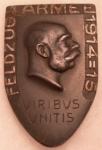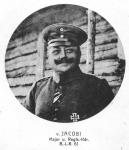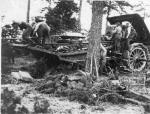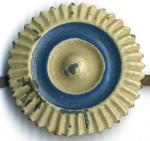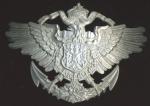-
Posts
2,962 -
Joined
-
Last visited
Content Type
Profiles
Forums
Blogs
Gallery
Events
Store
Everything posted by Chip
-

Otto von Schjerning
Chip replied to Komtur's topic in Germany: Imperial Uniforms, Headwear, Insignia & Personal Equipment
Komtur, Very interesting photos. What a career! Just for interest's sake, here is a picture of a shoulder board of a Prussian Generalstabsarzt der Armee from roughly the same time period as your 1906 photo. It looks like he might even be wearing the same pattern board. Chip -
I don't believe that the religious composition of the divisions had anything to do with the assignment of Milit?rgeistlichen. For the Prussians, at least, there was a standard number of Catholic and Protestant clergy assigned. The numbers of Catholic vs Protestant clergy remained roughly equal throughout the war, even in the Bavarian army, which had, by war's end, 225 Catholic priests and 280 Protestant clergy. The Jewish troops had only 30 Rabbis by 1918, but then they contributed only about 1% of the army's total. Chip
-
Well, you would think a nurse might not be a combattant, but given the right circumstances...... Years ago I went to visit an American doctory that served in WWII. He showed me a minature pistol that he took from a German nurse, who was carrying it for self protection. She had been told that if captured by the Americans she would be raped and therefore felt that she needed to carry it. Chip
-
Wonderful photos Robert. Congratulations! Your CdV of from M?nchen of the Einj?hrig Freiwilliger is not from the Inf.Leib Regiment. The shoulder strap shows a small crown with a royal monogram beneath. The Leibers only had a crown. Also, there are no Litzen on the collars and cuffs as a Leiber would have had. I suspect he is from the 1., 2. or 3. I.R., all of which wore a monogram. A close-up of the shoulder strap might solve the mystery. Chip
-
What intrigues me is the fact that this guy is wearing a M10/15 tunic with the full Bavarian Kennzeichenborte, which was only worn this way (supposedly, by regulation) from March 1916 to December 1917. This would lead one to guess that this was his walking-out-dress tunic, which had the braid added to it some time before the 1917 date. It appears to be in too good a condition for a field tunic that by the time this photo was taken was over three years old. The shoulder straps have been replaced by a pair having what looks like a rounded upper edge and without the normal unit number or device. If he were infantry, the post-1916 strap's piping would have been white and any other unit would most likely not been field gray (pioneers-black, foot artillery-yellow, field artillery-red, etc.), so I'm going with replacement straps. Chip
-

unknown shoulder board
Chip replied to Naxos's topic in Germany: Imperial Uniforms, Headwear, Insignia & Personal Equipment
Naxos, This could be a Reichsbahn or police shoulder strap (depending on the dark central color) from a later period, i.e., 1930s to 1945. Not imperial, however. Chip -
Edwardo, Thanks! Exactly what I was looking for. You know, there is not much information out there concerning navy gear. I find it interesting that the breadbag itself is similar to the WWII period army breadbag, but the shoulder strap still resembles the WWI version with the exception of the materials used. I collect imperial navy items myself and have both the earlier red/brown canvas navy bag and strap and the gray, wartime navy bag (unfortunately, without a strap). I had bought one of these WWII straps thinking that it might be a gray WWI version, but when I got it in and saw the materials, I knew immediately that it was not what I had hoped for. Thanks for the reply. Chip
-

Artyman?
Chip replied to Chris Boonzaier's topic in Germany: Imperial Uniforms, Headwear, Insignia & Personal Equipment
Chis, I think the dark cap band and the crossed cannons on the sword hilt verify that he is an artillerist. The badge is an Austrian tinnie with the profile of Franz Joseph I. It is one of the most common badges, but unusual to see a German wearing it. The Austrain tinnie you see most commonly being worn by Germans is the one from the 11.Armee. The tinnie in your picture is a motif used in several badges, but in this case I would guess it is the one from the 4.Armee. Chip Picture from - http://www.kappenabzeichen.it/index.php -
Thanks for that info Rick. Unfortunately, no date on the back of the photo. There is a message in schrift which I can only partially make out as it is somewhat faint. The uniforms (M07/10) would fit in with that period, but I have no knowledge of whether this gun existed at this particular time. Chip P.S. I looked through von Stein's notes and found the "Schwere K?sten-M?rser-Batterie Nr.6" attached to the 6.Armee and armed with one 30,5 cm Mrs.
-
I recently bought this postcard photo of Major von Jacobi, which I thought was interesting because it looks like it may have been made to distribute to the troops of RIR 61. Otherwise, why would such a labeled card be made of a field grade officer? In reading through the actions of the regiment, I cannot see anything of particular note. The Ehrenrangliste shows only one Major v. Jacobi, but no other real information. I have a 1911 Rangliste that shows two v.Jacobi majors, so I don't know which one he is. Any ideas? Chip
-
Are there any good sources of information on Kriegsmarine landing gear? For instance, I would like to see what a navy breadbag looked like. Were they like the WWI German navy bags? I have made a cursory search of the web and can find no information on what gear the navy would have worn on shore. Chip
-
Chris, Wonderful photos. It's rare to find such outstanding photos of military priests. There are several good photos in Kraus's book, but these are equally nice. In a similar vein, may I ask other readers, was there such a thing as enlisted assistants or other enlisted personel assigned to the priests and Protestant chaplains? I ask because I have seen an issue enlisted man's visorless cap with the same purple/violet band and piping as on the Feldgeistliche visored officer's style cap. Chip
-
I have this photo of a crew working on a 30,5 cm gun. I have looked around at various websites and cannot locate other pictures or more information about this gun. In many ways, it looks like the 42cm M-Ger?t (Dicke Berta), but the picture is marked otherwise. Can anyone verify the identification of this gun? Secondly, the photo has a note that it was taken by Rezan or Rozan. I have also had no luck finding out just where this is. Any help would be most appreciated. Chip
-
Roeland, Just one more observation. The Bavarian cockade on your blue cap is most likely incorrect. This is the 1916 pattern cockade that was introduced in March of that year. Your cap, though it could have been worn by troops in Germany, who were still wearing the old Dunkelblau uniform parts, would have had the earllier style cockade. I have shown the style you need below. Chip
-
Peter, A very nice helmet indeed. These are few and far between, especially in good condition. Yours looks excellent. The III. See Batl. wore this style helmet, but just for clarification, not with this front plate. Here is my example, made from aluminum for China duty. Sorry for the scan, but the plate is convex and does not show up well. Chip
-
Chris Liontas, I think I could speak for everyone else here who would like to see some more of the studio photos of your priest. This insignia is extremely hard to find and it would be good to see close-up what it looked like. For instance, I have never before seen a cape with the neutrality symbol on it. Thanks, Chip




